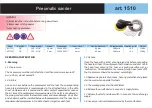
INSTALLATION (CONTINUED)
Power Source
1. The motor is designed for operation on the voltages and
frequency specified.
2. Normal loads will be handled safely on voltages not more than
10% above or below the specified voltage.
3. Running the unit on voltages which are not within the range
may cause overheating and motor burnout.
4. Heavy loads require the voltage at motor terminals be not less
than the voltage specified. Power supply to the motor is
controlled by a single pole locking rocker switch. Remove the
key to prevent unauthorized use.
Grounding Instructions
Refer to Figures 4 and 5.
Improper connection of equipment
grounding conductor can result in the risk
of electrical shock. Equipment should be grounded while in
use to protect operator from electrical shock.
Check with a qualified electrician if grounding instructions are not
understood or if in doubt as to whether the tool is properly
grounded.
This equipment is for use on less than 150V, and is equipped with
an approved 3-conductor cord and a 3-prong, grounding type plug
(see Figure 4) for your protection against shock hazards.
Grounding plug should be plugged directly into a properly installed
and grounded 3- prong grounding-type receptacle.
Do not remove or alter grounding prong in any manner. In the event
of a malfunction or breakdown, grounding provides a path of least
resistance for electrical shock.
Do not permit fingers to touch the
terminals or plug when installing or
removing from outlet.
Plug must be plugged into matching outlet that is properly installed
and grounded in accordance with all local codes and ordinances.
Do not modify plug provided. If it will not fit in outlet, have proper
outlet installed by a qualified electrician.
Inspect tool cords periodically, and if damaged, have repaired by an
authorized service facility.
Green (or green and yellow) conductor in cord is the grounding
wire. If repair or replacement of the electric cord or plug is
necessary do not connect the green (or green and yellow) wire to a
live terminal.
Where a 2-prong wall receptacle is encountered, it must be
replaced with a properly grounded 3-prong receptacle installed in
accordance with National Electric Code and local codes and
ordinances.
This work should be performed by a
qualified electrician.
A temporary 3-prong to 2-prong grounding adapter (See Figure 5)
is available for connecting plugs to a two pole outlet if it is properly
grounded.
Do not use a 3-prong to 2-prong grounding adapter unless
permitted by local and national codes and ordinances.
(A 3-prong to 2-prong grounding adapter is not permitted in
Canada.) Where permitted, the rigid green tab or terminal on the
side of the adapter must be securely connected to a permanent
electrical ground such as a properly grounded water pipe, a
properly grounded outlet box or a properly grounded wire system.
Many cover plate screws, water pipes and outlet boxes are not
properly grounded. To ensure proper ground, grounding means
must be tested by a qualified electrician.
Extension Cords
• The use of any extension cord will cause some drop in voltage
and loss of power.
• Wires of extension cord must be sufficient in size to carry and
maintain adequate voltage.
• Do not use extension cords over 25 ft. Cord must be at least
18 A.W.G.
• Use only 3-wire extension cords having 3-prong grounding
type plugs and 3-pole receptacles which accept the tool plug.
• If the extension cord is worn, cut or damaged in any way,
replace it immediately.
Extension Cord Length and Guage
Length
A.W.G
Up to 25 ft
18
NOTE:
Using extension cords over 25 ft. long is not recommended.
6
G
ET
TI
N
G
S
TA
R
TE
D
SA
FE
TY
/
SP
EC
IF
IC
AT
IO
N
S
A
SS
EM
B
LY
/
IN
ST
A
LL
AT
IO
N
O
PE
R
AT
IO
N
TR
O
U
B
LE
SH
O
O
TI
N
G
M
A
IN
TE
N
A
N
C
E
/ R
EP
A
IR
NORSE Operating Manual & Parts List 9681119
Figure 4 – 3-Prong receptacle
Properly grounded outlet
Grounding prong
3-Prong plug
Figure 5 – 2-Prong receptacle with adapter
Grounding lug
Adapter
3-Prong plug
2-Prong
receptacle
Make sure this is
connected to a known
grounded receptacle
9681119_oipm_En012_9643311.01 03/21/18 Page 6






























